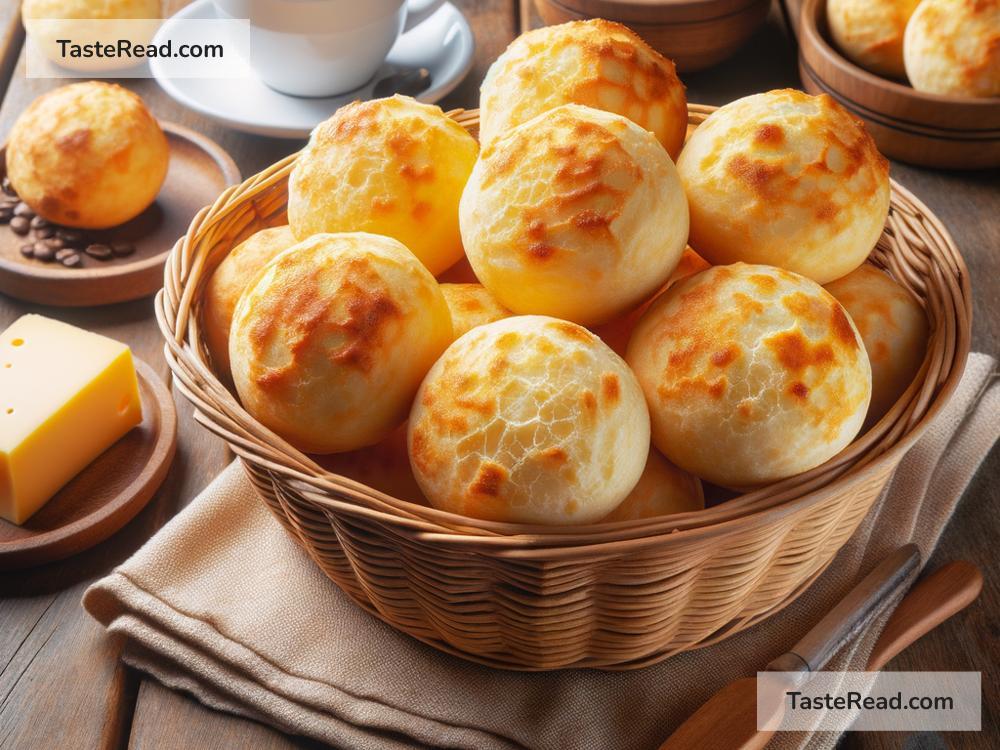Pão de Queijo: A Beloved Brazilian Snack with Historical Roots
Brazil is a country famous for its incredible culture, vibrant music, and delicious food. Among its many culinary treasures, one snack stands out as a favorite for locals and visitors alike: pão de queijo, which means “cheese bread” in Portuguese. These small, chewy cheese buns are loved by people of all ages and are often enjoyed with a cup of coffee or as a quick bite during the day. But did you know that pão de queijo has deep historical roots that trace back to simpler times in Brazil’s past? Let’s explore the story of this beloved snack.
What Is Pão de Queijo?
At first glance, pão de queijo may look like a normal bread roll, but don’t be fooled! These delightful treats are quite unique. Thanks to their special texture, pão de queijo has a crisp outer layer and a soft, chewy inside. This consistency comes from one of its key ingredients: cassava flour, also called “tapioca starch.” Cassava flour is gluten-free, making pão de queijo a popular snack option for people who avoid wheat or gluten.
Alongside cassava flour, the other star of the recipe is, of course, cheese. The dough is typically mixed with grated cheese, often a soft and mild Brazilian cheese such as queijo minas. However, recipes vary, and many people use other types of cheese, like parmesan, to add a bolder flavor. The finished product is a bite-sized roll that combines the light, airy texture of cassava flour with the richness of melted cheese.
While pão de queijo is eaten at any time of day, it’s especially popular during breakfast or afternoon coffee breaks. Whether you enjoy it paired with a strong cup of coffee or on its own, one thing is certain—pão de queijo is irresistible!
Historical Roots: A Snack Born from Tradition
The story of pão de queijo goes back hundreds of years, connecting it to Brazil’s colonial past. In the 1500s, Portuguese colonists introduced cassava to Brazil. Cassava is a root vegetable that was already a staple food for the Indigenous peoples of South America. The colonists quickly adopted cassava as a reliable crop because it thrived in Brazil’s tropical climate and was easy to cultivate.
Cassava flour became a vital ingredient in Brazilian cooking during this era, in part because wheat flour was scarce and expensive. Cassava’s versatility led to its use in various recipes, including breads and cakes. However, the earliest versions of pão de queijo didn’t contain cheese. These simple cassava rolls were made with water, salt, and eggs—ingredients that were widely available to Brazil’s rural communities.
Cheese wasn’t added to the recipe until much later, when dairy farming started to flourish in Brazil. In the state of Minas Gerais, which is famous for its dairy products, locals began incorporating cheese into their baked goods. Over time, this adaptation turned the humble cassava roll into the cheesy, flavorful delight we know today as pão de queijo.
By the mid-20th century, pão de queijo had grown in popularity across Brazil. It was no longer just a regional snack—it became a nationwide favorite. Today, it is an essential part of Brazilian cuisine and can be found in homes, bakeries, cafes, and even restaurants serving traditional food.
A Cultural Icon
Pão de queijo is more than just a snack; it’s a symbol of Brazilian culture and hospitality. The simple act of sharing warm bread with friends or family reflects the warmth and friendliness of Brazil’s people. Many Brazilians have fond memories of eating freshly baked pão de queijo while gathered around the kitchen table with loved ones.
What makes this snack even more special is its ability to bring people together. In Brazil, it’s common to see pão de queijo served during coffee breaks at work or during casual social gatherings. Many bakeries and cafes keep ovens running throughout the day to ensure that customers can always enjoy this treat fresh and warm.
Pão de queijo has also gained international attention in recent years. Travelers to Brazil often fall in love with these cheesy buns and search for them back home. As a result, bakeries in other countries now sell pão de queijo, and frozen versions have become widely available worldwide. Some people even make it at home to recreate the taste of Brazil in their kitchens.
Easy to Make and Enjoy
One reason pão de queijo is so adored is its simplicity. It requires only a handful of ingredients, yet the result is something so delicious that it feels special. Making pão de queijo at home is easy, and many recipes allow for experimentation with cheeses and flavors. As long as cassava flour is available, anyone can bake these little cheese buns with minimal effort.
Whether you make them yourself or buy them from a bakery, the joy of eating pão de queijo lies in its comforting and familiar taste. It’s a reminder of Brazil’s rich culinary heritage and its ability to transform simple ingredients into something truly extraordinary.
Final Thoughts
Pão de queijo is not just a snack—it’s part of Brazil’s heart and soul. Its historical roots, delicious flavor, and cultural significance make it one of the country’s most cherished foods. From the farms of Minas Gerais to bustling cafes in São Paulo, pão de queijo has a way of bringing people together and brightening any occasion.
If you ever find yourself in Brazil, be sure to taste this beloved snack. And if you’re far from Brazil, don’t worry—you can still enjoy the magic of pão de queijo by making it at home or finding it at a local bakery. Once you take that first bite, you’ll understand why Brazilians have been loving it for generations.


